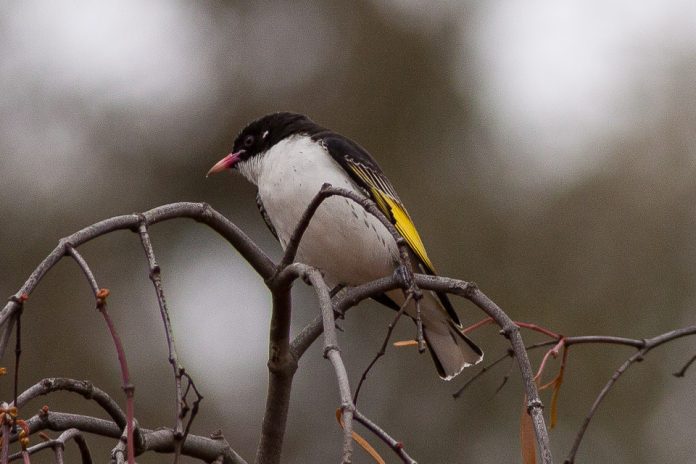Painted Honeyeater call is a melodious undulating whistle; churr. However, the song of Painted Honeyeater is stridently whistled tort-tee, tort-tee, or et-tee, et-tee. At the beginning of breeding, males may arrive several weeks before females and establish territory with tree-top singing and near-vertical song flights. Competitors are driven off in silent, weaving flights low among trees.
Identification
The size of the Painted Honeyeater is about 155-160 mm in length. The male bird’s head, upperparts, wings, and tail are black; flight and tail feathers broadly edged yellow; tail tipped white; white ear tuft. Underparts white, streaked black on flanks. The eyes are brown with a pink bill and dusky tip along with slate feet. The female bird’s upper parts are grayer, flanks plainer. However, the immature bird looks like a female.
Plumaged in contrasting black, white, and yellow, the Painted Honeyeater (Grantiella picta) feeds almost exclusively on the drupes of mistletoe. It has been recorded feeding on no more than five species of mistletoe Amyema, and to keep itself in food it follows their fruiting nomadically north and south over inland eastern Australia.
Nesting and Breeding
Both sexes construct the nest, taking up to three weeks, and both share incubation, changing over within hourly intervals. Both also feed the young, on insects as well as mistletoe drupes, and rear two foods in a good season. The breeding and nesting seasons are October-March. The honeyeater builds a nest a frail cup, 50 x 45 mm inside, of fibrous rootlets, casuarinas needles, or grass bound with cobwebs; attached to leafy twigs at the end of the drooping branch 4-20 meters above the ground level.
Eggs
The bird lays two eggs, which are salmon-pink, with small spots of red-brown and lilac, particularly at the larger end; oval, 20 x 15 mm. Thus, the incubation period is 13-15 days, for both sexes. The baby bird fledges in two weeks.
Distribution
The distribution of Painted Honeyeater is open forest and woodland in much of inland eastern Australia, uncommon and nomadic.
Related Reading – Grey-headed Honeyeater Call

